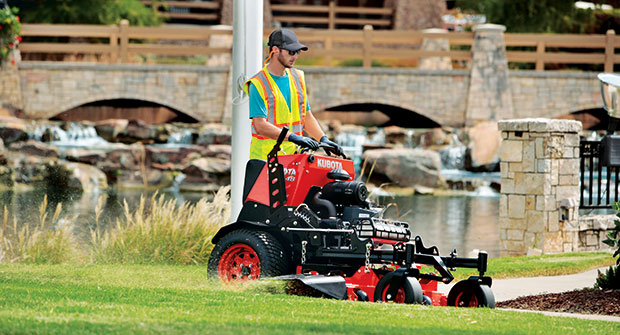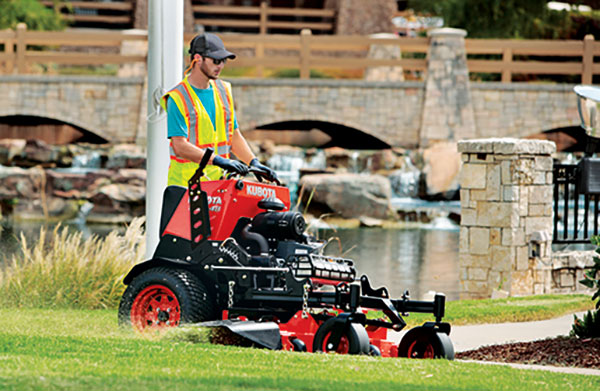
Mowing and maintenance can be a consistent service offering for landscape companies, but consistency might not equal profitability considering the labor shortage — 71,000 unfilled full-time positions in 2017, according to data from the National Association of Landscape Professionals.
Too much work and not enough people to do it can wreak havoc on a company’s bottom line.
We explore how three companies are growing their maintenance businesses, getting more efficient and overcoming a lack of qualified labor through mowing equipment technology.
Autopilot technology: An aftermarket mowing assistant
It’s not uncommon for Hugh Cooper to see a stand-on mower zip by on a lawn without an operator.
The COO of Russell Landscape Group (RLG), a $38 million landscape company in Atlanta, is in the midst of testing Greenzie autopilot technology for a segment of the company’s stand-on mowers. RLG has gone through four iterations of feedback and testing of the autonomous robotic mower.
Entrepreneur Charles Brian Quinn and co-founder David Cummings created Greenzie. A software developer by trade, Quinn was previously involved in Lawn.com, where he developed the desire to solve problems in the turf industry through software.
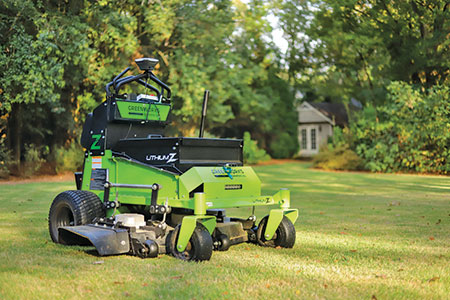
Greenzie was an answer to a couple questions that Cummings asked Quinn about the robotic mowers that they used on their home lawns: “How come there’s no Tesla of lawn mowers? How come there’s no software-based approach that gets better?”
Quinn spent a lot of time with landscapers and asked them about their expertise in robotics and what he should build. He was hearing responses like, “Call it tight immigration, but the labor is not there,” or “It’s the worst it’s been in my 18 years. I need a way to reduce the cost of labor.”
Quinn and Cummings hired a robotic engineer and a software engineer and set off building a prototype robotic kit that could retrofit onto existing stand-on zero-turn mowers, which they found to be more efficient than ride-on mowers. The kit works on a variety of gas-powered stand-on mowers and the Greenworks lithium-ion electric stand-on mower.
A single operator gets on the zero-turn, travels the boundary of the yard in the mower and the mower records it.
Instead of guide wires installed in the ground, as is the case with robotic mowers, the autonomous robotics kit mounted on the mower recognizes a software-based boundary. The operator then sets the direction that he or she wants the mower to mow, hits “stripe” and the zero-turn begins to mow.
“It’s dumb, but it’s a very good worker, like a robot should be,” Quinn says. “All it does is go back and forth and puts nice stripes on the lawn. Then it texts you when it’s done so you can move it to the next area. While it’s doing that, you can be edging and weeding.”
Greenzie autonomous robotic technology has been in existence for a year and a half, and Greenzie pilot programs are in progress with landscape companies in the Atlanta area, including BrightView and HighGrove Partners.
The technology currently costs $833 per month per kit, which comes to about $10,000 per year for each mower it’s installed on.
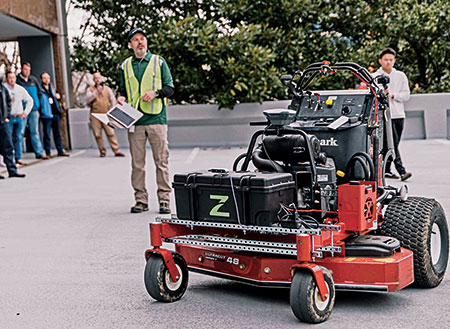
“We want to make sure that we’re setting the technology up for success so that the company is embracing it as a valuable tool as we go forward,” Cooper says.
He foresees that while the robotic-enabled mower might not be on every Russell Landscape crew at first, there will be robotic mowing crews that will go out to large jobs where the Greenzie mowers will handle 80 percent of the turf on that route — mostly institutional properties, sports fields and large areas where the mower can navigate.
“I’m thinking that five or 10 years from now, mowers will be designed to accommodate robotic mowing,” Cooper says. “If you have a property that can be 100 percent robotic mowing, you’re lowering your cost and it’s a huge opportunity.”
Robotic mowers: A labor saver
Joe Langton stumbled onto robotic mowers four years ago. At the iLandscape Show in Schaumburg, Ill., the owner of Langton Group spotted the Automower at the Husqvarna booth. “They didn’t even have it on Astroturf, they had it running right on the carpet,” he recalled. “Most people walked by and thought it was a vacuum cleaner.”
Where some people saw a novelty or a robot threatening to replace the job of a human, Langton saw an opportunity to grow his business and overcome his labor problems.
Langton Group is a $6 million operation offering landscape maintenance, construction/irrigation and snow removal. It serves a 35 percent commercial, 60 percent residential and 5 percent municipal clientele in the Chicago area.
In addition to the company’s 24 traditional gas-powered mowers — a mix of Gravely propane-powered zero-turns and Husqvarna walk-behinds — the Langton Group has 92 Husqvarna Automowers currently in service. This is a far cry from the four robotic mowers he initially started with, and further even still from the 300 mowers he hopes to have running by the end of 2020.
In year one, Langton received a lot of pushback from his clients on the idea of installing Automowers on their properties. One concern was that robotic mowers don’t provide the precise striping of traditional ride-on mowers and rather move through the lawn in a random pattern, similar to a robotic vacuum.
“They were saying, ‘I want (striping). If you’re going to use a robot, I’ll use someone else,’” Langton says.
The company’s pitch was that the customer would save money on maintenance and then could reinvest that money into other projects such as hardscaping.
People were still skeptical.
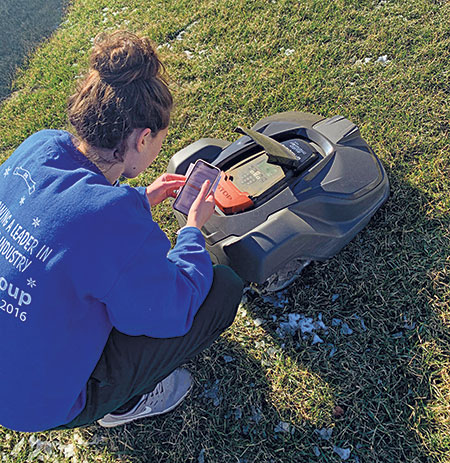
In year two, Langton hit on the service model that ended up resonating with his clients. He began converting his yearly mowing and maintenance contracts to four-year agreements of eight months on with a robotic mower and four months off, with the company storing the units in the off-season.
Langton Group primarily installs the Automowers on homeowners’ association and commercial properties. The installations entail a single technician delivering a precharged mower and docking station to a customer, locating the utilities and checking the power source. The technician has a map of the property and where the wires will be located, and then lays out guide wires and uses a cable winch to install the guide wires 4 inches underground. Installation times range from four hours up to eight hours for the largest mower, which covers approximately 1.25 acres.
The monthly rate includes the installation fee. If customers cancel their contracts before four years, they have to pay back their installation fees, valued at $1,000. That installation fee drops $250 after each year anniversary.
Langton Group sells what it calls an Eco Bundle to its clients, similarly named after Husqvarna’s discount program on robotic and electric products. The Eco Bundle includes the Automower, a four-year service agreement and a technician completing nonrobotic tasks, such as line trimming and weed eating every other week. Husqvarna battery-powered hedge and string trimmers, backpack blowers and walk-behind mowers are used on these jobs, converting the customer to all battery power.
The company calculates the amount of carbon it saves with the Automowers: 27,600 pounds of CO2 saved in 2019.
And for the clients concerned that their lawns wouldn’t have precise stripes? Langton says, “I’ve combated that by asking them to name two times per year that they really need stripes and we’ll come and do them for $40 each. They never call.
“I have no desire to have a landscape company outside of northern Illinois, but I do have a desire to share my passion for robotic lawn mowers nationally,” Langton says of his affinity for robotic mowers.
He’s started a company called Automated Outdoor Solutions (AOS), where he’s added a distribution channel for robotic mowers. AOS supplies other landscape companies, including operations such as Mariani Landscape, also in the Chicago area, with Husqvarna Automowers.
Customers often want their lawn mowed on a Friday. Mariani Landscape and Langton Group subscribe to the idea that with robotic mowers, “every day’s a Friday,” because these mowers allow them to offer daily mowing to their customers at a weekly price.
Automowers range from $1,999 to $3,400. Over the last several years, Langton has invested $325,000 in robotic equipment and install fees. He’s seen 20 percent savings in mowing costs and 80 percent savings in mower maintenance due to the Automowers’ two-year warranty.
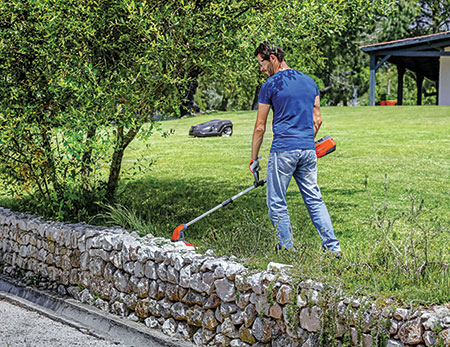
Steve Uljua, product manager for robotics at Husqvarna, explains that the ability to track the unit while it’s in motion, the cost of labor and the labor shortage are main factors that make robotic mowing appealing.
“The cost just gets too expensive to hire somebody, with workmen’s comp and insurance and the things that are associated with having employees,” he says.
Langton employs two Automower technicians who manage the fleet using the Husqvarna Fleet Services app. He’s found that once he’s trained them on servicing the mower in the field and running the app, a single technician can manage 50 units.
“Instead of hiring people who are lawn mowers, I take people who are really good time-management employees but maybe weren’t good running a zero-turn, move them out of that segment of the business and make them an Automower technician,” he says.
His 19-year-old daughter, Julia, monitors the company’s entire fleet. “She’s my right hand when it comes to (robotic mowers),” Langton says. “She’s better at it than I am.”
He believes that robotic mowers are an opportunity that women and young, tech-savvy people can truly embrace to get into the landscaping industry.
“(Julia) is such a critical part, and we’re attracting the younger people who want to work with us because of this technology,” he says.
Electronic fuel injection: More power and efficiency
Jody Sepulvado is the owner of JLT Landscape Professionals in Shreveport, La. The $2.7 million company performs 50 percent maintenance, 30 percent enhancements and 20 percent installation services, serving a 70 percent commercial and 30 percent high-end residential clientele.
Sepulvado founded the company 20 years ago as a small lawn service company, but it has since grown and now has a nursery operation to support its maintenance business. JLT Landscape hasn’t taken its eyes off of growth.
One thing that has helped Sepulvado grow his business in recent years is mower technology that allows his crews to operate more efficiently.
JLT Landscape Professionals uses a mix of Kubota and John Deere mowers. Sepulvado says the addition of airless radial tires has helped increase efficiency.
“The (airless radial tire) helps contribute to the fact that we have zero downtime attributed to flat tires in the morning,” he says. “Our rollout is about 15 percent more efficient with (airless radial) tires because we’re not airing up tires not enough or too much. It’s taking a problem off the repairs of the equipment.”
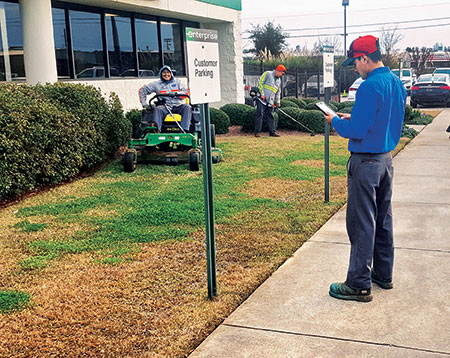
He adds that the developments in electronic fuel injection has helped his company increase its efficiency because it gives more power throughout the day and decreases user error, which makes training new employees more efficient.
George Reister, product manager for Husqvarna, says that the widespread adoption of electronic fuel injection (EFI) has helped increase the efficiency of commercial lawn mowers. It increases the power to the engine, allowing contractors to mow lawns cleanly and more quickly.
“Electronic fuel injection is a power efficiency,” he says. “EFI mowers are able to cut a deeper variety of grasses with less damage to the grass because there is more power.”
He also notes that increases in transmission technology contribute to speed and acceleration as well.
The decrease in the amount of maintenance time is one of the biggest improvements in mowing tech, says Tom Vachal, senior product manager for Kubota.
“I would say increase in productivity and decrease in maintenance are the two biggest things I feel have really helped landscapers in multiple ways to grow their businesses, to get the job done faster, to either allow them to expand or to spend more time at home, whatever they choose to do,” he says.
According to Vachal, some manufacturers and companies are using better oils and fuel systems, reducing the amount of oil change time and the frequency of oil changes.
“Instead of, many times they’re 100 hours, well, now mowers are at 500 or 1,000 hours, or maybe a whole season, so (contractors) don’t have to stop or take the machine out of service to do a periodic oil change with some systems,” he notes.
Advances in technology give companies that adopt them an edge, Reister says.
“The company that adopts early gains a competitive advantage. If I’m running a fleet and can cut more in a day and have fewer injuries and higher retention, I can beat my local competitors and gain three extra accounts a year.”
With the labor issue at the back of most landscape contractors’ minds, retaining employees is top of mind. Autonomous or robotic mowers are one way to
ease the problem, but ride-on and zero-turn mower manufacturers are also trying to address the problem by making the machines simpler to operate and more comfortable.
“Basically, it’s like owning a car. If you want to own a luxury car or if you want to own an economy car,” Vachal says. “It’s easier to put someone in a luxury car and feel like you’re driving a very nice machine, if you will, as opposed to an economy one, which may not have the comfort features. It may be a little more rigid on the suspension. Trying to give them a more pleasant experience is really, I think, where some of it’s going.”
Reister says that if operators can use machines in a way so their arms or legs are in a natural position that allows them to have better posture and more comfort, then people will be more likely stay with a company longer.
“Adding comfort to zero-turns is an important part of the efficiency equation,” he says. “An operator can cut longer without so much bumping around, so suspension seating is an important part of that.”
Regulations will likely be one of the major driving forces behind the development in new technologies for zero-turn mowers.
“The internal combustion engines, while I don’t think they’re going to go anywhere for some time, I think they’re going to have to improve,” Vachal says. “They’re improving efficiencies from an emission standpoint, but there are a lot of people looking at battery-powered.”
Sepulvado is one such company owner. Though he currently runs his fleet on gasoline and diesel fuel, he says his company’s goal is to switch to electric equipment by 2021. “The main reason for electric is No. 1, the noise level and No. 2, the ethanol gas problems we experience in the two-cycle world.”
